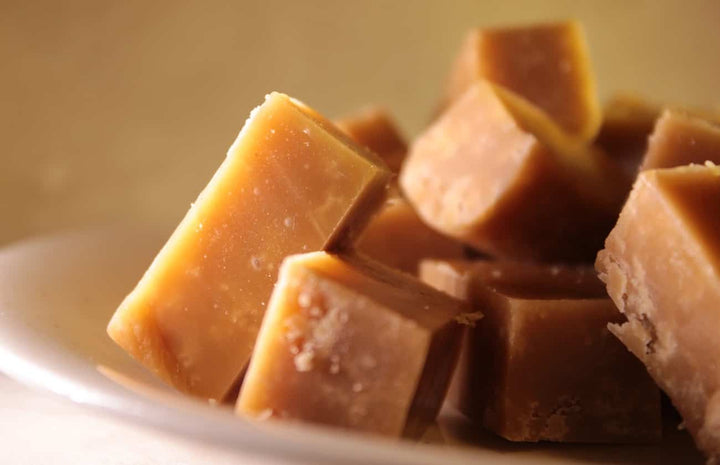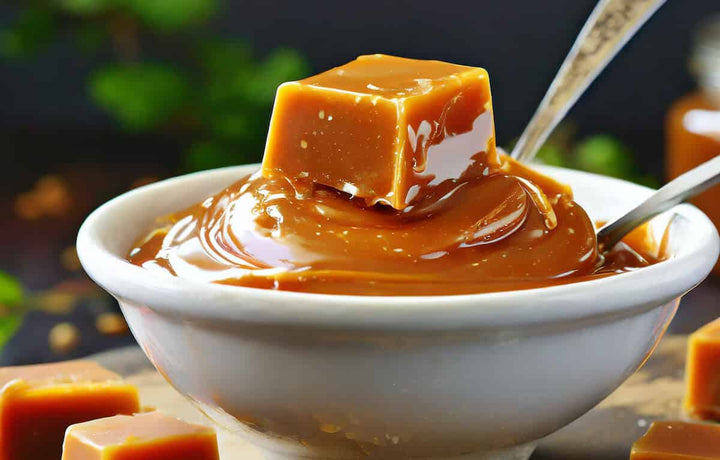Understanding the shelf life of fudge is crucial to enjoying its scrummy flavour to the fullest and ensuring it is eaten safely.
This post will explore the various factors that influence fudge longevity and provide practical tips on storing your fudge effectively, ensuring every bite remains as divine as the first.
So, if you're a fudge aficionado keen on keeping your treats in tip-top condition, read on to discover the secrets of prolonging the life of your favourite sweet indulgence.
How Long Does Fresh Fudge Last?
The shelf life of fresh fudge, a beloved sweet treat, largely depends on the ingredients used and the storage conditions.
Fresh homemade fudge lasts about 1 to 2 weeks at room temperature.
It's essential to store it in an airtight container to prevent exposure to air and moisture, which can hasten spoilage.
Storing fudge in the refrigerator is effective if you wish to extend its longevity.
Under refrigerated conditions, it can last for 2 to 3 weeks.
Again, ensure it's in an airtight container or wrapped tightly to prevent it from absorbing odours from other foods and from drying out.
For even longer storage, fudge can be frozen.
When wrapped correctly in wax paper or aluminium foil or placed in a freezer-safe container, fudge can last in the freezer for up to 3 months without losing its quality.
Thawing is straightforward - leave it at room temperature for a few hours before consumption.
However, it's important to note that the texture and consistency of fudge may change slightly when refrigerated or frozen.
Refrigeration makes it firmer, while freezing alters its texture upon thawing.

How to Store Fudge
To properly store fudge and maintain its quality, allow homemade fudge to cool at room temperature before placing it in an airtight container to prevent drying out.
Keep it at room temperature in a cool, dry place for up to two weeks for short-term storage.
For more extended storage, refrigerate the fudge for up to three weeks or freeze it for up to three months using appropriate wrapping.
Always use clean utensils to handle fudge and check for any signs of spoilage before consuming.
These methods ensure your fudge remains fresh and enjoyable for an extended period.
Can You Store Fudge in the Fridge?
Storing fudge in the fridge effectively prolongs its freshness, particularly in warm or humid conditions.
To do this, place the fudge in an airtight container to prevent it from absorbing fridge odours and drying out.
Optionally, wrapping each piece in cling film or wax paper provides extra protection against moisture and smells.
Remember that refrigeration changes the fudge's consistency, making it firmer, so if you prefer a softer texture, let it sit out briefly before eating.
Fudge stored in the fridge can last for 2 to 3 weeks.
Regularly check the fudge for any signs of spoilage, such as odd smells, mould, or texture changes.
Ensure there's no excess moisture in the container to prevent softening or mould growth.
This method ensures you can enjoy your fudge for longer, with the right texture and flavour.

Can You Store Fudge in the Freezer?
Fudge can be successfully stored in the freezer, an excellent method for extending its shelf life.
To freeze fudge effectively, it is essential to wrap it tightly in cling film or wax paper to prevent freezer burn and retain moisture.
Then, placing it in a freezer-safe container or bag offers additional protection and helps preserve its flavour and texture.
Labelling the container with the freezing date is useful, as fudge can be kept in the freezer for up to three months without significantly losing quality.
When you're ready to enjoy the fudge, allow it to thaw gradually at room temperature, as quick methods like microwaving can alter its texture.
Although freezing might slightly change the texture of the fudge, the taste should remain largely the same.
It's advisable not to refreeze fudge after thawing to maintain its quality.
Freezing in portions can be practical if you plan to use the fudge over time, allowing you to thaw only what you need.

What Type of Container is Best for Storing Fudge?
When storing fudge, the choice of container is paramount to maintain its freshness and flavour.
The ideal type of container for storing fudge should possess certain key characteristics:
-
Airtight Containers: The most crucial feature is that the container must be airtight. Airtight containers prevent the fudge from absorbing moisture and odours from the surrounding environment, which can alter its taste and texture. Additionally, they help in keeping the fudge from drying out.
-
Material: Glass or hard plastic containers are typically recommended, but glass is non-reactive and doesn't impart any flavours or odours to the fudge. Plastic containers are also suitable, provided they are food-grade and free from harmful chemicals.
-
Size and Shape: Choose a container that comfortably fits your fudge without too much extra space. Excess air in the container can lead to quicker spoilage. The shape isn't as crucial, but square or rectangular containers can be more space-efficient for storage in your pantry, fridge, or freezer.
-
Stackability: If you have multiple containers, it's practical to choose stackable ones for efficient use of space, especially if you're storing them in the fridge or freezer.
-
Wrap Beforehand: For additional protection, wrap the fudge in cling film or wax paper before placing it in the container. This step is particularly beneficial if you're storing different flavours of fudge together, as it prevents the flavours from mingling.
-
Label and Date: If you’re storing different batches of fudge or for an extended period, it’s helpful to label the containers with the contents and date of storage.
The best container for storing fudge is an airtight one, preferably made of glass or food-grade plastic.
What Can You Do With Fudge That Has Gone Hard and Dry?
If you find yourself with fudge that has gone hard and dry, don't despair!
There are several creative and delightful ways to repurpose it. Here's what you can do:
-
Fudge Sauce: Melt the hard fudge with milk or cream over low heat, stirring continuously. Once it reaches a smooth consistency, you've got a delicious fudge sauce. It's perfect for drizzling over ice cream, pancakes, or waffles.
-
Baking Incorporation: Chop the hard fudge into small pieces and use them as mix-ins for cookies, brownies, or cakes. They'll add a lovely texture and flavour to your baked goods.
-
Fudge Crumbs: Crush the hard fudge into fine crumbs and use them as a topping for desserts like sundaes and yoghurt parfaits or as a base for a pie crust.
-
Hot Chocolate Enrichment: Add small pieces of hard fudge to your hot chocolate for an extra-rich and decadent flavour. Allow the fudge to melt into the warm drink, stirring occasionally and slowly.
-
Dessert Garnish: Grate the hard fudge and use it as a garnish on top of desserts for a touch of elegance and extra flavour.
-
Fudge Truffles: Melt the hard fudge, mix it with a bit of cream, reshape it into small balls, and then roll them in cocoa powder or crushed nuts. You've now transformed it into delightful fudge truffles.
-
Microwave Softening: To soften the fudge, try microwaving it for a few seconds. Avoid overheating it; it can become too runny or burn.
-
Fudge Pudding: Melt the fudge with milk and incorporate it into a custard base to create a rich and creamy fudge pudding.
By employing a bit of creativity, you can give new life to hard and dry fudge and turn it into an array of tasty treats.
These methods save your fudge from going to waste and add a delightful twist to various desserts.
Does Fudge Go Off?
Fudge can go off, even though its high sugar content is a natural preservative.
The shelf life of fudge varies based on the ingredients used and the storage method.
Typically, homemade fudge lasts about 1 to 2 weeks at room temperature, 2 to 3 weeks in the fridge, and up to 3 months in the freezer when stored in an airtight container.
To determine if the fudge has spoiled, look for signs like an unusual smell, a change in texture, or the presence of mould.
Dry, hard, crumbly, or fudge with a white coating (crystallised sugar or mould) may indicate spoilage.
Storage conditions greatly influence fudge's freshness; it should be kept in a cool, dry place away from direct sunlight and heat.
The shelf life also depends on the ingredients; fudge containing dairy or eggs might spoil quicker and require refrigeration.
Commercial fudge usually contains preservatives, giving it a longer shelf life than homemade varieties.
If there's any doubt about a fudge's freshness, it's safer not to consume it.
What Happens if You Eat Old Fudge?
Eating old fudge may carry certain risks, depending on the extent of its spoilage. Here are the potential outcomes and considerations:
-
Stale Taste and Hard Texture: If the fudge is old but not spoiled, it might have a stale taste and a harder texture than fresh fudge. While it might not be as enjoyable, it's generally not harmful.
-
Risk of Foodborne Illness: If the fudge has spoiled – indicated by an off smell, mould growth, or a change in texture or colour – consuming it could lead to foodborne illness. Symptoms can include stomach discomfort, nausea, vomiting, and diarrhoea.
-
Digestive Issues: Eating old fudge, especially if it's gone hard, may also be difficult to digest, potentially causing minor stomach upset or discomfort.
-
Presence of Mould: The consumption of mouldy fudge should be avoided. Some moulds can produce mycotoxins, which can be harmful to health.
-
Allergic Reactions: For those with sensitivities or allergies, eating old fudge can sometimes trigger allergic reactions, especially if it has developed mould.
-
Rancidity: If the fudge contains fats like butter or cream, it can go rancid over time. Eating rancid fudge can result in an unpleasant taste and cause digestive discomfort.
When in doubt, discard any fudge that shows signs of spoilage or has been stored beyond the recommended time frame.
How Can You Tell if Fudge Has Gone Off?
Determining whether fudge has gone off involves a few simple checks. Here’s what to look out for:
-
Appearance: Fresh fudge should have a smooth, creamy texture. If you notice any mould growth or discolouration (such as white spots, which could be sugar crystallisation or mould), it's a sign that the fudge has gone off.
-
Texture: Over time, fudge may dry out and become hard or overly soft and sticky. While a slight change in texture doesn't necessarily mean it's spoiled, a significant alteration often indicates it's past its best.
-
Smell: Give the fudge a good sniff. Fresh fudge should smell sweet and inviting. If it has an off or sour smell, it clearly indicates it's no longer good to eat.
-
Taste: If the fudge looks and smells fine, but you’re still unsure, try a bit. If it tastes off or not like it should, it’s best not to eat any more.
-
Storage Time: Consider how long you've had the fudge. If it's been stored for longer than the recommended shelf life (1-2 weeks at room temperature, 2-3 weeks in the fridge, or up to 3 months in the freezer), it's more likely to have gone off.
-
Storage Conditions: If the fudge has been stored improperly – for example, in a humid environment or a non-airtight container – it may have deteriorated faster.
Remember, when in doubt, it's safer to discard the fudge rather than risk eating something that might be spoiled.
Where Can You Buy Tasty Fudge?
Whitakers fudge, celebrated for its exceptional richness and flavour, is crafted using traditional methods and real ingredients like clotted cream and butter, creating a truly indulgent and delightful treat.
Click here to see our delicious fudge...

Some Notes From an Expert Chocolatier
As an expert chocolatier, I take immense pride in continuing the tradition of making fudge using our famous original recipe.
This time-honoured approach preserves the classic, beloved taste and embodies our commitment to authenticity and quality in each batch we craft.
This dedication to traditional methods and genuine ingredients sets our fudge apart, ensuring a unique and memorable experience for every connoisseur.
Final Notes On How Long Fudge Lasts and How to Store It
Proper storage methods are crucial for ensuring the longevity of fudge and its ability to retain its delightful taste and texture.
Typically, homemade fudge can last 1 to 2 weeks at room temperature, 2 to 3 weeks in the refrigerator, and up to 3 months in the freezer when stored correctly.
The key to extending the shelf life of fudge is ensuring it's kept in an airtight container, away from heat and moisture.
This preserves its freshness and maintains the rich, indulgent quality that fudge is celebrated for.











